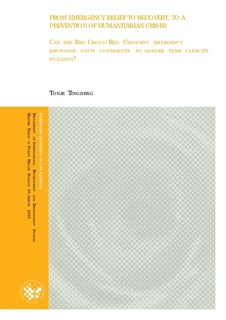From emergency relief to recovery, to a prevention of humanitarian crises. Can the Red Cross/Red Crescent emergency response units contribute to longer term capacity building?
Abstract
Background: Humanitarian crises are increasing both in number and complexity, recognition and efforts of preventive measures in humanitarian actions are accordingly needed. The International Federation of Red Cross and Red Crescent Societies (IFRC) coordinate a global Red Cross/Red Crescent disaster response. Norwegian Red Cross is one of the providers of health emergency response units (ERU), which is part of IFRC global disaster response system. The existing emergency response policy requires its members to actively plan and pursue capacity building in a disaster response operation as an effort to prevent future humanitarian crises. The main research issue for this master thesis are if the health ERUs can be used as a capacity building tool and how. Theory: Methods of long distance control drawn from the Actor Network theory have been used to interpret if ERUs can be used as a capacity building tool. In regard to how ERU can be used as tool in capacity building, a conceptual model of the capacity building paradox has been applied to achieve an understanding.
Method: A qualitative research was accomplished through a multi sited ethnographic field approach. In total16 interviews were carried out on site in Oslo and Jakarta, Indonesia, with informants affiliated to the ERU programme in Red Cross/Red Crescent movement. Indonesia were chosen since they received health ERU support from Norwegian Red Cross during the Tsunami in 2004/2005 and sufficient time has passed to explore the experience. To be able to follow the concept in different context interview subjects were chosen from all levels, from the decision maker to the delegate in the field. In addition informants from Ministry of Health in Indonesia participate due their involvement in the Tsunami ERU operation and since they received donation of health ERU after completion of ERU operation.
Findings: The technology of ERU is appropriate and functions well. Currently, the response equipment can be customized to the nature due to the flexibility of the modules. ERUs supporting existing health structures increase and improve recipient societies disaster preparedness programmes. The lack of clear objectives and the differences in the training of practitioners with new curricula vs. old mixed together is a risk in regard to the intention of capacity building. Additionally limited knowledge of the ERU delegate in the Red Cross/Red Crescent mandate and partner National Societies ignoring the partnership become a risk in regard to organisational capacity building.
Conclusion: To enable a long distance control of the intention of building local capacity preventing humanitarian crisis, a system that is well anchored in the IFRC global systems and policy must be adopted. This can be achieved by better preparing delegates for partnership work and by communicating clear objectives for the emergency response operation. This can improve the short term ERU intervention in order to successfully build local capacity in emergency situations, which can contribute to prevention of future humanitarian crises.
